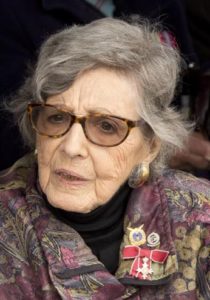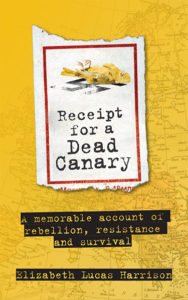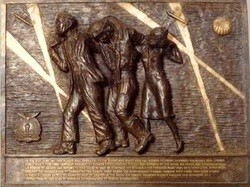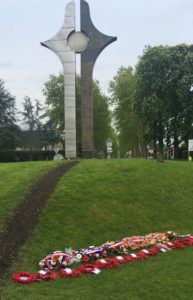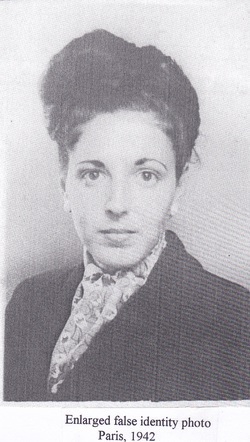Rog Stanton
Elizabeth Harrison was a founding member of ELMS – No3. She became a committee member and took on the role of ‘Helper Liaison’ – keeping the Society in touch with the helpers. She never sought any credit for her activities on behalf of the Society and performed her duties willingly, out of genuine interest and concern. She was a source of knowledge and inspiration to all members; she kept in touch with helpers and informed the committee of problems; she acted as interpreter, liaison and translator; maintained contact with many aircrew evaders, and shared her wealth of knowledge and experiences garnered throughout her amazing life and as Secretary to the RAF Escaping Society.
Elizabeth was a ‘one off’ – a survivor, an evader, a veteran of the French Resistance, a lady of great intelligence, wisdom and character. She was a source of wise counsel, possessed a wicked sense of humour and had a remarkable memory with the ability to recall names and events from the wartime years as if it were yesterday.
I first dealt with Elizabeth soon after her appointment as Secretary to the Royal Air Forces Escaping Society in 1978. She was appointed on her 55th birthday and worked for the RAFES for eighteen years until its closure in 1995, using her manual typewriter, carbon copies, a paper filing system and her phenomenal memory to keep in touch and produce her newsletters from her office in Brompton Road. The RAFES proved to be an international spider’s web of contacts, places and people worldwide. Multilingual, Elizabeth was soon known to all, and proved to everyone that she was the right person for the job. After its closure in 1995, Elizabeth worked with the RAFES Charitable Fund until the year 2000 when the fund was ‘wound up’. Throughout her years with the RAFES she worked tirelessly organising and co-ordinating events and meetings and acted as a conduit for keeping many aircrew evaders in contact with their helpers.
Elizabeth was a lady of many talents:
Poet, and author of the book ‘Receipt for a Dead Canary’ in which she wrote of her life experiences. [Available as an e-book].
Sculptress; in 1981 she sculpted the large RAFES bronze plaque, of an airman who had crash landed, being assisted by helpers to safety in the middle of the night. Today that plaque is prominent in the crypt of St Clement Danes Church in London. Replicas can be seen in Ottawa, Canada; Canberra, Australia; The RAF Museum at Hendon; The Basilica in Brussels; the Overloon War Museum in Holland; Les Invalides in France; and in Gibraltar, and in the basement of the RAF Club, as a legacy of the Canadian evader Al Day.
Elizabeth also designed the 30ft memorial, at Valencay in France, to the F Section members of SOE who lost their lives working with Resistance forces in France. The memorial was unveiled by the Queen Mother on May 6th1991, the 50th anniversary of the arrival in France of F Section’s first agent. A scale model of the memorial now stands on the Bar of the Special Forces Club in London.
Fundraiser; Elizabeth’s sense of adventure never left her, and on her 75th birthday she celebrated in style by doing a tandem freefall parachute jump raising £5000 for the helpers; she managed three jumps in total for charity. Her work with the RAFES was marked by the award of the MBE in 1996. In later years, and until her death, Elizabeth was a volunteer for SSAFA, visiting ex-servicemen in hospital in London. She was also a member of the Special Forces Club and attended events at the Allied Special Forces Grove.
Elizabeth was the daughter of a Jewish banker who had been wounded fighting at Verdun in 1916. Although always known as Elizabeth, she had been christened Liesel Ethel Marie Lucas, born on 8 March 1923 in Dusseldorf. She was educated at the Goethe Lyzeum. This was at the time of the German depression and the rise of the Nazi Party. By 1933 all classes and teachers in Germany began each day with a Nazi Salute. Her father, seeing the way things were heading, moved the family out of Germany and by 1934 the family were in a flat in Brussels. Elizabeth attended the Lycee de St Gilles where she became a Girl Guide and also trained for the Red Cross; both activities would help her in the years to come. In 1938, Elizabeth travelled to Teddington in England on a school exchange visit and immediately fell in love with England, vowing to return.
The outbreak of war on 3rd September 1939, found her training to be a secretary. On the 10th May 1940 the Germans invaded Belgium and later the family were arrested as enemy aliens – betrayed by a neighbour who had also been arrested. Although arrested as Germans, the Belgians discovered that the family were Jewish refugees and released Elizabeth, her mother and her brother; her father remained interned in a camp for a further three months. Taking a small amount of luggage, the three family members left Brussels and headed south for the border with France only to be turned back because their papers stated German nationality. They then headed for the most southern seaside resort in Belgium at De Panne. After witnessing the departure of British troops from the beach they sought refuge in a house, which they left quickly when it was shelled by German troops. On the 31st May the Germans took the small village and they were all forced to return to Brussels where Elizabeth began working for the Belgian Red Cross treating the casualties of the war.
Jews were required to wear the Star of David on their clothing, and Elizabeth’s father, now back in Brussels, sensed imminent deportation to Germany. So, in 1942, he decided to move the family to France, this time to Paris, and then to cross the demarcation line between occupied France and Vichy. They arrived in Paris but found difficulty getting out; after three failed attempts they were assisted by railway men and hidden on a goods train which they left at Givors in Vichy France.
There, without the knowledge of her family, Elizabeth became a courier – between Givors and Lyon – delivering messages for the Resistance and distributing stores and equipment following SOE parachute drops. After the liberation of southern France in August ‘44 she placed her FFI [Forces Francaises de l’interieur] badge proudly on her arm, only then to discover that her father had been working for the Resistance too!
Elizabeth next moved to a field hospital to work for the Red Cross, caring for Resistance fighters, German troops and civilians injured in the fighting. In October 1944 she returned to Belgium and worked for the American Red Cross and the British Red Cross. One of her many jobs was working with concentration camp victims arriving at main stations and trying to unite them with their families. Many were very sick, others could not even remember their own names. Most were from Belgium and the Netherlands. It was a very disturbing time.
Later in 1946 Elizabeth moved on to the YMCA – to the War Prisoners Aid Scheme. Speaking fluent German, French and English she travelled throughout the low-countries. She also accompanied inspection teams touring the camps and was often present when senior German officers were questioned. For her work Elizabeth was awarded the Belgian Red Cross Medal. At the end of the war she was to find that many of her extended family had perished in the concentration camps. Their German death certificates are now held in Eden Camp Museum.
After the war Elizabeth married a British Army Officer, Alexander Manson, and moved with him to South Africa and then Rhodesia; they had two children. The marriage was subsequently dissolved. Elizabeth married John Harrison in 1963 and with him she moved to England in 1968. John Harrison died in 1982. While in Africa Elizabeth became a member of the Capricorn Africa Society, founded by Col David Stirling, who also founded the SAS.
Elizabeth Lucas Harrison MBE, a modest yet remarkable lady, died on 10 July 2016 age 93.

